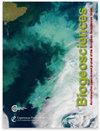Origin and role of non-skeletal carbonate in coralligenous build-ups: new geobiological perspectives in biomineralization processes
IF 3.9
2区 地球科学
Q1 ECOLOGY
引用次数: 0
Abstract
Abstract. The coralligenous build-ups located on the Mediterranean shelf in front of Marzamemi (SE Sicily, Italy) represent useful natural examples to use in studying the relationship between skeletal organisms and non-skeletal components in marine bioconstructions. Coralligenous build-ups are formed in open marine systems, and their comparison with coeval bioconstructions (biostalactites) of confined environments, like submarine caves, allows depicting the complex interactions between metazoans and microbial communities in the formations of recent bioconstructions in different Mediterranean settings. In this study, two coralligenous build-ups were characterized in terms of organisms and sediments involved in their formation. The framework mainly consists of coralline algae and subordinate bryozoans and serpulids. Sponges affect the general morphology of the bioconstructions both interacting with skeletonized organisms and through bioerosion activity. The micrite or microcrystalline calcite is present in minor amounts compared to other components that form the build-ups and consists of two types: autochthonous (in situ) and allochthonous (detrital). Fine autochthonous micrite mineralized directly inside the framework cavities and shows aphanitic or peloidal fabric, produced by organomineralization processes of soft sponge tissues and microbial metabolic activity, respectively. The detrital micrite occurring inside cavities derives from external sources or erosion processes of the bioconstructions themselves. This component has been classified as organic or inorganic based on the organic matter contents deduced by UV epifluorescence. A great quantity of sponges live in cavities of the coralligenous build-ups and compete with carbonatogenic bacteria for the same cryptic spaces, limiting the production of microbialites. The sharing of a similar relationship between sponges and microbial communities by coralligenous concretion and biotic crusts of particular submarine caves suggests that this competition is not habitat-specific. On the contrary, it may develop in a range of environmental settings, from open to cryptic systems, and could be used to clarify the role of metazoans vs. microbialites in palaeoecological reconstructions.非骨骼碳酸盐在珊瑚堆积中的起源和作用:生物矿化过程中新的地球生物学视角
摘要位于 Marzamemi(意大利西西里岛东南部)前方地中海大陆架上的珊瑚堆积物是研究海洋生物构造中骨骼生物与非骨骼成分之间关系的有用自然实例。珊瑚堆积物是在开放的海洋系统中形成的,将它们与封闭环境(如海底洞穴)中的共生生物构造(生物钟乳石)进行比较,可以描绘地中海不同环境中近代生物构造形成过程中原生动物和微生物群落之间复杂的相互作用。在这项研究中,从参与其形成的生物和沉积物的角度对两种珊瑚礁堆积物进行了描述。框架主要由珊瑚藻类和从属的虾藻类和蛇藻类组成。海绵通过与骨骼化生物的相互作用以及生物侵蚀活动影响着生物构造的总体形态。与形成堆积物的其他成分相比,微晶石或微晶方解石的含量较少,包括两种类型:自生(原位)和异生(碎屑)。细小的自生微晶岩直接在框架空腔内矿化,并显示出闪长岩或球状结构,分别由海绵软组织的有机矿化过程和微生物代谢活动产生。出现在空腔内部的脱屑微晶来自外部来源或生物构造本身的侵蚀过程。根据紫外线荧光法推断出的有机物含量,这种成分被分为有机和无机两种。大量海绵生活在珊瑚堆积物的洞穴中,与碳源细菌争夺相同的隐蔽空间,限制了微生物岩的产生。特定海底洞穴的珊瑚凝结物和生物结壳中的海绵和微生物群落之间有着类似的关系,这表明这种竞争并不是针对特定生境的。相反,从开放系统到隐蔽系统,它可能在一系列环境中发展,并可用于澄清元古动物与微生物岩在古生态重建中的作用。
本文章由计算机程序翻译,如有差异,请以英文原文为准。
求助全文
约1分钟内获得全文
求助全文
来源期刊

Biogeosciences
环境科学-地球科学综合
CiteScore
8.60
自引率
8.20%
发文量
258
审稿时长
4.2 months
期刊介绍:
Biogeosciences (BG) is an international scientific journal dedicated to the publication and discussion of research articles, short communications and review papers on all aspects of the interactions between the biological, chemical and physical processes in terrestrial or extraterrestrial life with the geosphere, hydrosphere and atmosphere. The objective of the journal is to cut across the boundaries of established sciences and achieve an interdisciplinary view of these interactions. Experimental, conceptual and modelling approaches are welcome.
 求助内容:
求助内容: 应助结果提醒方式:
应助结果提醒方式:


